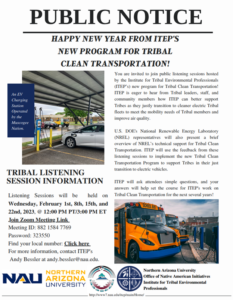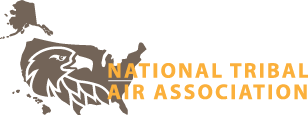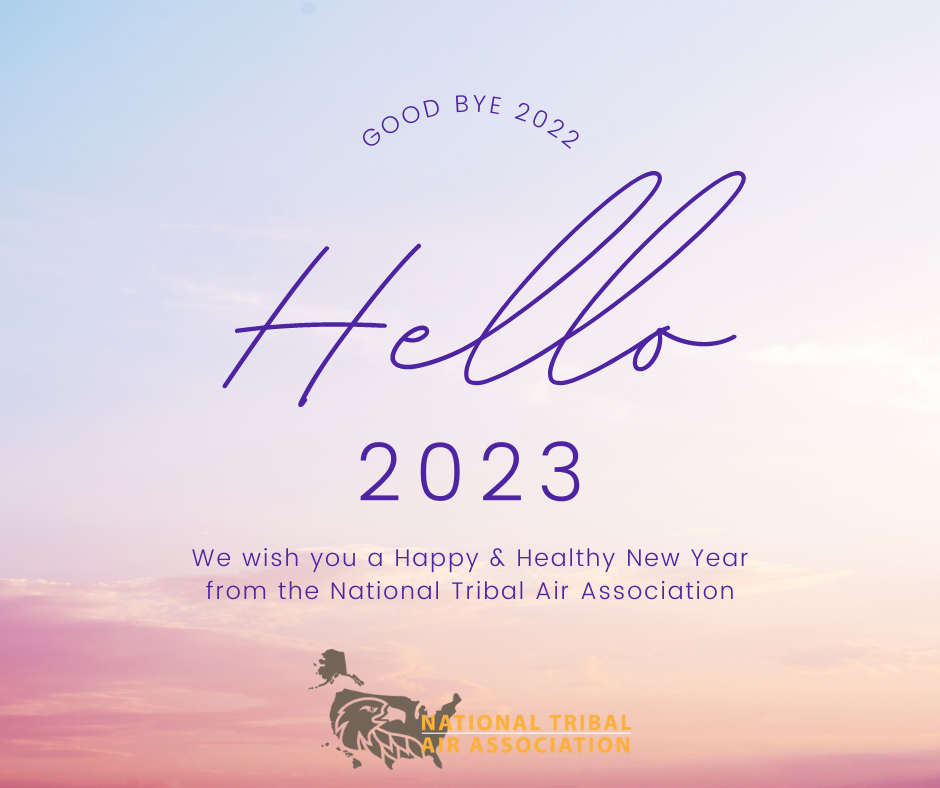PHOTOS FROM THE FIELD: Week of January 9 – 13, 2023
PHOTOS FROM THE FIELD
REMINDER! Call for proposals for NTFAQ 2023 is open until January 27th! All applications are welcome! The deadline for proposals is January 27th! https://forms.gle/GXLS8QztLLMs5H518
TOP STORIES/HEADLINES: Week of January 9 – 13, 2023
NTAA NEWS!
REMINDER! Call for proposals for NTFAQ 2023 is open until January 27th! All applications are welcome! https://forms.gle/GXLS8QztLLMs5H518
Join the national conversation on how Tribes are implementing the Clean Air Act in partnership with the U.S. EPA to improve air quality in our communities. Forum organizers are actively seeking proposals for presentations, trainings, and other informational sessions that support our NTFAQ conference goals! Proposals should relate to air quality topics relevant to tribal stakeholders and should discuss direct experiences and/or original research.
Timeline:
Presentation Proposals Due: January 27th, 2023
Letter of Notification (will include instructions and timeline): February 20th, 2023.
If you have questions about the agenda, presentation options, or other ways to participate in the event, please contact [email protected] or [email protected]


Top Stories
EPA.gov – EPA Proposes to Strengthen Air Quality Standards to Protect the Public from Harmful Effects of Soot
E&E – EPA Unveils 100M for Environmental Justice
The EOP Inflation Reduction Act guidebook is live and an excellent resource for stakeholders! IRA webpage with the “living guidebook” and links to the PDF and downloadable data set: https://www.whitehouse.gov/cleanenergy/inflation-reduction-act-guidebook/
IRA Guidebook PDF: https://www.whitehouse.gov/wp-content/uploads/2022/12/Inflation-Reduction-Act-Guidebook.pdf
NACAA – Washington Update
Ambient Air Quality/EPA/Tribes News
Environmental Defense Fund – EPA Methane Proposal makes critical progress but work remains to Quickly Finalize Protective Standards
CNN Health – EPA proposes new rule to crack down on deadly air pollution
Healio – Air pollution associated with nonviral asthma attacks among urban youth
Earthjustice – Why your Air Quality Matters and how you can fix It
NRDC – Local air quality monitoring lagging across U.S., NRDC Finds
Climate Change/Energy
GreenWire – Great Salt Lake could vanish in 5 years, report says
University of California – UC awards $16.4M in grants to address climate change, health inequities
NPR – Climate change makes heat waves, storms and droughts worse, climate report confirms
E&E Climatewire – How sending climate aid abroad helps the U.S.
Toxics/Mobile Sources
Geek Wire – Washington, Oregon, join California in requiring all new vehicle sales to be EVs by 2035
E&E – How carmakers are crafting the EV-charging experience
E&E – EPA inks deal to clean up Keystone spill
The Hill – Biden Officials lay out Roadmap for Net Zero Transportation by 2050
Indoor Air Quality
The Guardian – Too many smelly candles? Here’s how scents impact the air quality in your home
Harvard Business Review – Designing Buildings that are both Well-Ventilated and Green
Los Angeles Times – U.S. Safety Agency to Consider ban on gas stoves amid health fears
UPCOMING CALLS/EVENTS/NOTICES: Week of January 9 – 13, 2023
UPCOMING CALLS/EVENTS/NOTICES
Ambient Air Quality/EPA/NTAA/Tribes
Request for Nominations to the White House Environmental Justice Advisory Council Now Available!
Application Deadline January 17, 2023
The Council on Environmental Quality (CEQ) within the White House invites the public to submit expressions of interest in serving as members of the White House Environmental Justice Advisory Council (WHEJAC). The WHEJAC is charged with providing advice to the White House Environmental Justice Interagency Council (IAC) and the Chair of the White House Council on Environmental Quality (CEQ) on a whole-of-government approach to address issues related, but not limited, to environmental justice. This notice solicits expressions of interest to fill approximately fifteen (15) new vacancies for a two-year term. To maintain the representation outlined by the charter, nominees will be selected to represent the following stakeholder groups: academia; community-based organizations; non-governmental organizations; industry/business; state/local government; tribal government/indigenous organizations; faith-based organizations; public health; and youth-led or youth focused environmental organizations.
Specific information about how to apply and the criteria for appointment can be found at: https://www.epa.gov/environmentaljustice/white-house-environmental-justice-advisory-council
Submit expression of interest questionnaire and resumes for nomination electronically with the subject line WHEJAC Membership 2023 to [email protected].
For more information, contact: Karen Martin, U.S. EPA, by telephone at (202) 564-0203, or email at [email protected].
Latest Version of Motor Vehicle Emission Simulator (MOVES) Released!
EPA has posted MOVES3.1, a minor revision to MOVES3. MOVES3.1 adds an inspection/maintenance (I/M) program benefit for Class 2b and 3 gasoline trucks with a gross vehicle weight rating of between 8,500 and 14,000 pounds (Regulatory Class 41). With this minor revision, these trucks will now receive the same proportional I/M benefit for exhaust emissions as lower classification gasoline trucks. This benefit was missing in previous versions of MOVES.
MOVES3.1 is available for download at www.epa.gov/moves/latest-version-motor-vehicle-emission-simulator-moves. Please download and use this new version if you:
- have not yet used MOVES3,
- are conducting regulatory analyses involving an I/M program that includes gasoline passenger and light commercial trucks (of any regulatory class), such as performance standard modeling for an I/M state implementation plan (SIP) to demonstrate that an I/M program meets the applicable performance standard (refer to the Performance Standard Modeling guidance), or
- are conducting modeling for other SIP or transportation conformity analyses for an area where the I/M program includes gasoline passenger and light commercial trucks (of any regulatory class).
Otherwise, MOVES3 users can continue to use previous versions of MOVES3. For more information about regulatory uses of MOVES, see the MOVES3 Policy Guidance which applies to all versions of MOVES3.
This update is considered a minor revision, rather than a patch, because it may decrease onroad emissions of NOx, VOCs, and CO in some areas. However, it will not substantially change onroad criteria emissions rates at the County Scale and it is not considered a new model for SIP or transportation conformity purposes. As noted in the MOVES3 Technical Guidance, modelers should continue to review and update the relevant I/M coverage inputs to reflect the latest I/M assumptions in regulatory analyses.
Updated Version of EPA’s Air Sensor Guidebook Released!
Recognizing the ever-increasing availability of air sensors, expanding user base, and growing scientific knowledge, the U.S. EPA updated the popular Air Sensor Guidebook, originally published in 2014. The refreshed version, called “The Enhanced Air Sensor Guidebook”, includes updated content and new topics that incorporate best practices, current knowledge, and recommendations to guide the use of air sensors.
The Enhanced Guidebook supports users in planning and collecting air quality measurements using air sensors. The Guidebook can help sensor users:
- Learn the basics of air quality, air pollution monitoring, and air sensors
- Plan and conduct an air quality monitoring study
- Select, setup, and use air sensors
- Analyze, interpret, communicate, and act on results
- Understand the basics of air sensor performance
Find out more and access the Enhanced Air Sensor Guidebook.
Visit EPA’s Air Sensor Toolbox.
Find out more about EPA’s Air Research.
Applications are being accepted now for the nation’s highest award in asthma management!
The Environmental Leadership Award in Asthma Management is the nation’s highest honor for programs helping people bring asthma under control. Winners will be recognized in May during Asthma Awareness Month. Winning this award is a sign of excellence and confirmation of success in helping people with asthma lead healthy, active lives.
Winners receive:
- A place in the National Environmental Leadership Award in Asthma Management Hall of Fame.
- An engraved, crystal award.
- Recognition in May during Asthma Awareness Month.
- Recognition on national websites, including AsthmaCommunityNetwork.org.
- Customized press kits, a descriptive snapshot of your program and support generating media attention.
- An opportunity to serve as mentors to help other programs achieve impactful results.
For more information, visit the Asthma Community Network HERE
Smoke, Air, Fire, Energy (SAFE) Symposium – Rural and Tribal Community Resilience Strategies for Action Day-long symposium on March 1st, 2023, that will bring together Tribal leaders, researchers, and practitioners who are working on the interrelated topics of wildfire smoke, air quality, fire risk, and clean energy solutions. The goal is enhancing climate resilience of rural and Tribal communities. There is no cost to attend this event. Click HERE for more information and RSVP HERE.
EPA Seeks Feedback on Inflation Reduction Act Programs
Comments are due by January 18, 2023. In addition, the agency will conduct extensive public engagement as it works to implement the law.
EPA has announced initial public engagement and input opportunities for a subset of new and existing programs funded by President Biden’s Inflation Reduction Act. These programs, which include funding for air quality and climate projects addressing clean energy, transportation, methane emissions, and climate super-pollutants, will advance the President’s bold agenda to combat the climate crisis, protect public health and advance environmental justice.
EPA’s engagement strategy for these programs includes:
- Request for Information (RFI): Issuing a request for public input to inform program design;
- Expert Input: Soliciting expert input on key program design questions from EPA’s Federal Advisory Committees including the Local Government Advisory Committee, Clean Air Act Advisory Committee, and the National Environmental Justice Advisory Committee;
- Listening Sessions: Launching a stakeholder listening session series to enable key stakeholders including environmental justice communities, state and local governments, clean energy advocates, labor, and others to provide input directly to EPA staff; and
- New Webpage: Creating a one-stop shop for information on the implementation of Inflation Reduction Act programs managed by EPA’s Office of Air and Radiation.
EPA has published a Request for Information (RFI) seeking public comment on six public dockets that correspond to Inflation Reduction Act provisions in the law.
Public Encouraged to Review and Comment in Six Public Dockets
- Docket 1: Climate Pollution Reduction Grants
- Docket 2: Transportation Programs
- Docket 3: Methane Emissions Reduction Program
- Docket 4: Funding to Address Air Pollution
- Docket 5: Funding for Implementation of American Innovation and Manufacturing (AIM) Act
- Docket 6: Low Emissions Electricity Program & GHG Corporate Reporting
- The RFI and more information on how to comment is available at this website.
REMINDER! The White House: FACT SHEET: How the Inflation Reduction Act Helps Tribal Communities
By signing the Inflation Reduction Act, President Biden is delivering on his promise to meet the climate crisis and build an economy that works for working families, including Tribal nations and American Indian, Alaska Native, and Native Hawaiian families. The Inflation Reduction Act lowers prescription drug costs, health care costs, and energy costs. It’s the most aggressive action we have taken to confront the climate crisis. It’ll lower the deficit and ask the super wealthy and corporations to pay their fair share. And no one making under $400,000 per year will pay a penny more in taxes. Click Here for FACT SHEET.
U.S. Environmental Protection Agency (EPA) FY2022 Appropriations
This document was prepared by the Congressional Research Service (CRS). CRS serves as nonpartisan shared staff to congressional committees and Members of Congress. It operates solely at the behest of and under the direction of Congress. Information in a CRS Report should not be relied upon for purposes other than public understanding of information that has been provided by CRS to Members of Congress in connection with CRS’s institutional role.
EPA’s Community and Tribal Programs Group has a publicly facing Tribal Actions and Events calendar for all to use!
This calendar is also linked under the “Tribal Air and Climate Resources” webpage under the “Policy and Planning” heading available at https://www.epa.gov/tribal-air. The purpose of the calendar is to ensure that our Tribal partners are kept apprised of EPA activities that are relevant to them. If you have any questions about the calendars or any recommendations on how EPA can improve upon the calendars, please do not hesitate to reach out to Loren Fox ([email protected]) with any feedback.
Air Knowledge E–Learning Content
The Air Knowledge training team is pleased to announce the availability of new air quality training materials!
These e-learning courses and modules are at the foundational learning level and are available to Tribal, state, and local air agencies through our learning management system (LMS) and to the public here. The website was recently enhanced to provide additional self-instructional and instructor-led training materials.
The new materials include:
- A course that explains key historic events that led to air pollution control legislation and describes progress made with air pollution control since the passage of the Clean Air Act,
- A course that explains the basic components of state and Tribal implementation plans,
- A module that generally defines the transport and fate of air pollutants and how transport and fate are influenced by meteorology and topography,
- A module that explains the basic aspects of an air emissions inventory, and
- A module that explains the purposes and types of air emissions inventories, including the inventories that the EPA develops.
To access the courses and modules on the LMS (https://epaapti.csod.com), Tribal air agencies and organizations can register, log in, and refer to the “What’s New” section on the home page. All other users (the public, international community, academia, industry, EPA staff, etc.) can access the courses and modules on the Air Knowledge interim website.
NTAA Upcoming Calls
Contact [email protected] if you have any questions about any call! *Registration instructions for NTAA webinars* When you register for GoToWebinar, please remember to include your Tribe, Region, or Organization in parenthesis after your last name. This allows you to see everyone on the call and prevents us from conducting a rollcall, ultimately saving time. For other NTAA calls, NTAA will be transitioning to Zoom. A Zoom link will be sent with calendar invites for future NTAA work group calls.
| Woodsmoke Work Group: This work group meets Bi-Monthly and includes Tribal and EPA professionals with an interest in woodsmoke issues in Tribal communities. Contact [email protected] to join the call! | Thursday,
January 19, 10 am AK or 2 pm ET |
| Mobile Sources Work Group: This work group meets Bi-Monthly and includes Tribal and EPA professionals with an interest in mobile source issues in Tribal communities. Contact [email protected] to join the call! | Thursday, February 2,
10 am AK or 2 pm ET |
| Alaska Air Work Group: Join this work group to hear updates from EPA and Alaskans working on air quality. Contact [email protected] to join the call! | January 25,
10 am AK or 2 pm ET |
| NTAA / EPA Air Policy Update Call: Join this monthly meeting to hear updates from EPA on important air quality and climate policy updates as well as updates around the country related to Tribal Air Programs. Calls are usually on the last Thursday of every month unless it falls on a national holiday. Contact [email protected] to join the call! | Thursday, January 26, 10 am AK or 2 pm ET |
| Indoor Air Quality (IAQ) Work Group: This work group meets Bi-Monthly and includes Tribal and EPA professionals with an interest in indoor air quality in Tribal homes and other buildings. [email protected] to join the call! | Thursday, February 16, 10 am AK or 2 pm ET |
The Institute for Tribal Environmental Professionals (ITEP)
Click Here for ITEP’s new Tribal Environmental Management and Planning Online Courses. Sign up for a self-paced course hosted by ITEP’s Waste and Response and Tribal Air Quality programs.
ITEP’s American Indian Air Quality Training Program (AIAQTP) hosts the Building Performance: Improving IAQ in Cold Climates, Residential Building Science Review, Radon Fundamentals, Quality Assurance Fundamental, Writing a Quality Assurance Project Plan, Emissions Inventory Fundamentals, and Emissions Inventory Advanced.
AIAQTP Schedule and Registration
Recorded Webinars
Looking for more information check out the Tribal Air Quality Media Space Channel. Recent webinars include an Introduction to Air Quality Programs, Emissions Inventories, Remote Professional Assistance, and Woodstoves in Indian Country. Older classics include a series on Air Quality Planning for Wildland Smoke, Tribal Air Program and Grants, Data Management, and the Clean Air Act.
ITEP’s Tribes and Climate Change Calendar includes conferences, trainings, webinars, and other events related to Tribes and climate change.
EPA Tools and Resources Webinar Series
Click here to see all past and upcoming webinars hosted by the EPA.
Climate Change / Energy
Regional Tribal Environmental Health Summits
The National Indian Health Board (NIHB) is partnering with the Centers for Disease Control and Prevention (CDC) to host a series of regional summits on the topic of environmental health in Indian Country. Each summit will feature Tribal leaders, environmental health practitioners, subject matter experts, and federal partners engaging on topics relevant to each region. A total of eight summits will be held between 2022 and 2024. The goal of each summit is to connect people from different backgrounds and Tribes, communities, federal agencies, Tribal organizations and state and local entities to address various environmental health and environmental justice issues of mutual concern across all regions as well as issues specific to individual regions. The first confirmed summit is May 1 – May 2, 2023, in Anchorage, Alaska.
More details here
RFI EPA Climate Pollution Reduction Grants – $5 billion
Deadline: January 18, 2023
This RFI is for a program to help eligible entities to help plan and implement climate pollution reduction strategies. Click here for more information.
Toxics/Mobile Sources
Opportunity to provide input: the U.S. Environmental Protection Agency (EPA) is developing a proposed rulemaking to review the Clean Air Act (CAA) New Source Performance Standards (NSPS) and Emission Guidelines (EG) for the Large Municipal Waste Combustors (LMWCs) source category (40 CFR part 60 subpart Eb, and 40 CFR part 60, subpart Cb, respectively). Pursuant to the EPA’s Policy on Consultation and Coordination with Indian Tribes, the Agency is initiating pre-proposal consultation with federally recognized Indian tribes to obtain input on the upcoming action to update regulatory requirements for the Large Municipal Waste Combustors (LMWCs). If you are interested in requesting government-to-government consultation with EPA during the pre-proposal period, please contact Regina Chappell at (919) 541-3650 or email at [email protected]. Please contact us before February 3, 2023, to request the consultation. EPA will strive to accommodate the requests as time and resources permit. Tribes may also submit OFFICE OF AIR QUALITY PLANNING AND STANDARDS written comments at https://www.regulations.gov/, Docket ID No. EPA-HQ-OAR-2022-0920, any time during the pre-proposal tribal consultation process and until June 6, 2023. If there are any questions, please email Charlene Spells at [email protected]. Additional background information about the air regulations for LMWCs can be found at: https://www.epa.gov/stationary-sources-air-pollution/large-municipal-waste-combustors-lmwc-new-source-performance
Indoor Air Quality
Notice of Intent – DOE Grants for Energy Improvements at Public School Facilities – $80 million
Deadline: Available until expended. Eligible Entities: Consortium of One Local Education Agency and one or more Schools, Non-Profits, For-Profits, and Community Partners
This funding is the first tranche of funding in a $500 million investment, to make clean energy improvements in K-12 public schools. Funds will empower school districts to make upgrades that will lower facilities’ energy costs and improve student learning environments. Visit HERE for more information.
Available Now: An Introduction to Radon Gas in Homes Webinar Recording
EPA’s Indoor Environments Division recently hosted a webinar to provide an overview of the key basic facts of radon – what it is, what it does to us, how we measure it, how we reduce our exposure, and where to find resources and additional information. A recording of An Introduction to Radon Gas in Homes is now available online. The recorded webinar features a presentation by Bruce Snead, Director of Engineering Extension at Kansas State University, and director of the National Radon Program Services effort for EPA since 2009.
EPA: A Fact Sheet for Tribes on State and Tribal Indoor Radon Grants
EPA’s Indoor Environments Division is pleased to announce the State and Tribal Indoor Radon Grants (SIRG) Program Fact Sheet. This fact sheet has information on SIRG eligibility, matching requirements, allowable activities, EPA contacts, and more. EPA works collaboratively and values our Tribal partnership to support healthy indoor air quality (IAQ) in Tribal communities. We work together to develop tools and resources that address the health and the safety of Tribal members when it comes to indoor air quality.
Please visit the Indoor Air Quality in Tribal Communities or State Indoor Radon Grants (SIRG) Program and Resources pages to learn more and download the fact sheet.
Be sure to subscribe to CodeTalk, HUD’s Office of Native American Programs newsletter, for webinars and opportunities!
RESOURCES AND FUNDING OPPORTUNITIES: Week of January 9 – 13, 2023
RESOURCES & FUNDING OPPORTUNITIES
NOW HIRING!
REMINDER!
The Department of Religious Studies is hiring an 1855 professorship in the position of Great Lakes Anishinaabe Knowledge, Spiritualities, and Cultural Practices.
Applications closes: July 8, 2024, | Click Here for Full Job Description
The Department of Religious Studies is hiring an 1855 professorship in the position of Great Lakes Anishinaabe Knowledge, Spiritualities, and Cultural Practices. We seek a scholar with a focus on Anishinaabe communities, and more broadly, Great Lakes Native American cultures. The scholar’s areas of interest should include Anishinaabe worldviews, ceremony, knowledge systems, and communal cultural practices in the context of colonialisms, resistance, resiliency, and sovereignty. The specific area of focus is open with preference to knowledge of traditions of Anishinaabe communities, and more broadly, Native American communities. We are particularly interested in scholars whose work and teaching complement cross-university strengths in environmental practices, North American Indigenous Law, communal health and wellness, and social justice. In keeping with our land-grant mission, we seek a scholar engaged in public-facing conversations about how contemporary Native American knowledge, language, spiritualities, and culture can inform larger discussions around law, public policy, land stewardship, resource management, community health and wellbeing, Tribal governance, museum collections and archives, and environmental justice movements.
Ambient Air Quality/EPA/NTAA/Tribes
REMINDER! Selections for the ARP Enhanced Air Quality Monitoring Competitive Grant
EPA selected 132 projects, in 37 states, to receive a total of $53.4 million to conduct ambient air monitoring of pollutants in communities across the country with environmental and health outcome disparities stemming from pollution and the COVID-19 pandemic. EPA will start the process to award the funding by the end of 2022, once the grant applicants have met all legal and administrative requirements. This table can be sorted by clicking on each column header. A downloadable version is available HERE.
EPA Resource: EPA is pleased to announce that we have updated our Local Greenhouse Gas Inventory Tool and our Tribal Greenhouse Gas Inventory Tool.
Updates include:
- Revised Emissions & Generation Resource Integrated Database (eGRID) factors from through 2020, as available.
- Updated default stationary energy emission factors and heat contents from the latest Climate Registry, EPA GHG Emissions Factor Hub, and US Inventory publications.
- Global Warming Potential (GWP) values are now editable on the Factors tab. The bottom of the Control Sheet tab also contains new guidance on updating the GWP values and a navigation button to the GWP Entry section on the Factors tab.
Download the updated local community and government operations tool and users’ guides.
Download the updated tribal community and government operations tool and users’ guides.
Find our State Inventory and Projection Tool and additional State and Tribal greenhouse gas data and resources here.
EPA Resource: EPA’s Home Heating Fuel Use Web App
Are you curious about how people heat their homes? EPA has developed a Home Heating Fuel Use Web App that lets you visualize American Community Survey 5-year average home heating fuel data across the U.S. by census tract. Use this data to inform outreach or implementation planning related to energy efficiency, residential electrification, wood stove change-outs, and more.
EPA Resource: EPA’s Tracking Matrix
Does your community have climate goals to meet or brownfields that might be suitable for solar? Check out EPA’s Tracking Matrix to learn more about geothermal, biomass, solar and wind installations being built on contaminated lands across the country. EPA’s RE-Powering America’s Land Initiative 2022 Tracking Matrix shows current trends in the development of renewable energy on contaminated lands. Project examples include successful community solar projects in Nashville, Tennessee; Schenectady County, New York; Morrisville, Vermont; and Spanish Fork, Utah.
Tribal Air Quality Flag Program Packet
Customize this flyer/poster template to share information with your community about air quality, how it can affect health, and actions to take on a bad air quality day.
You may need a PDF reader to view files on this page. See EPA’s About PDF page to learn more. Tribal Air Quality Flag Program Packet
Department of Energy (DOE) Announces $32 Million to Reduce Methane Emissions from Oil and Gas Sector
All interested applicants must register and submit application materials through Fed Connect; register here for an account. All questions about the FOA must also be submitted through FedConnect.
Air Monitoring Equipment Available for Loan to State, Local, and Tribal Agencies
In 2021, EPA’s Office of Research and Development initiated the Wildfire Smoke Air Monitoring Response Technology (WSMART) Pilot, loaning air monitoring technologies to state, local, and Tribal air organizations to support supplemental air monitoring in areas affected by wildfire smoke and with observational data coverage gaps. During 2022, this pilot technology loan program will continue to provide several technology types – including stationary air sensor systems and a compact mobile monitoring system – to state and local air agency monitoring staff and professional Tribal air quality staff members upon request. The equipment is not available for public use. For more information and access to the loan request webform, please visit the WSMART website:https://www.epa.gov/air-sensor-toolbox/wildfire-smoke-air-monitoring-response-technology-wsmart-pilot
For technical questions, please contact [email protected].
To view and/or receive ITEP’s American Indian Air Quality Training Program newsletter, Native Voices, click here!
Climate Change/Energy
EPA’s State and Local Climate and Energy Program will use this newsletter to share updates and opportunities as they become available and to let you know how the EPA’s IRA programs can help your jurisdiction.
Our monthly funding newsletter will also continue to provide information on climate and clean energy grant and technical assistance opportunities and deadlines for state, local, and Tribal governments. You can also visit the White House’s website about clean energy and climate action in the IRA. Use it to learn how you can save on utility bills, get support to purchase electric vehicles, energy-efficient appliances, and more. Share the news: Tax Credits for Energy-Efficient Home Upgrades have been Extended!
Under the IRA, federal tax credits for energy-efficient home upgrades have been extended. This means that if you made any qualifying home improvements to your primary residence after December 31, 2021, you may be eligible to claim credit on your federal taxes when you file for 2022. Qualifying upgrades include ENERGY STAR-certified products, as well as improvements to your home’s envelope or exterior – such as windows, doors, and insulation. To learn more, read through ENERGY STAR’s property tax credit guidance.
Renewable Energy tax credits have also been extended and will be available through the end of 2023. These include incentives for Geothermal Heat Pumps, Residential Wind Turbines, Solar Energy Systems, and Fuel Cells.
What’s New for Federal Tax Credits in 2023? There will be new efficiency tax credits in place starting January 1, 2023, lasting 10 years – through 2032. The tax credit amount is generally limited to 30% of the project cost. The previous lifetime cap of $500 has been changed to an annual cap of $1,200 to $2,000 depending on the efficiency improvements you make. This means you will be able to claim credit for more projects, especially if they are spread out over multiple years.
For more information and to stay up to date on available tax credits, make sure to bookmark ENERGY STAR’s page on Federal Tax Credits so you can maximize savings on your home energy efficiency projects.
Join NCAI’s Climate Action email listserv here!
Sign up for the Alliance for Green Heat’s newsletter!
To view and/or receive ITEP’s Climate Change newsletter, click here!
Toxics/Mobile Sources
U.S. Department of Energy: Electric Vehicles with Final Assembly in North America
The Inflation Reduction Act of 2022 (Public Law 117-169) amended the Qualified Plug-in Electric Drive Motor Vehicle Credit (IRC 30D), now known as the Clean Vehicle Credit, and added a new requirement for final assembly in North America that took effect on August 17, 2022. For more details on the credit, see Electric Vehicle (EV) and Fuel Cell Electric Vehicle (FCEV) Tax Credit. Also see the full list of alternative fuel vehicle incentives amended or created by the Inflation Reduction Act. Click Here for more information.
Indoor Air Quality
Resource for Healthy Indoor Air Quality:
Check out the website https://forhealth.org/ for many resources related to healthy homes and indoor air quality!
The Tribal Healthy Homes Network (THHN) has a webpage dedicated to Funding Opportunities! Additionally, THHN has developed a Funding Guide for American Indian and Alaska Native Communities.
Alaska
NEW! 2022 Building Resilient Infrastructure and Communities (BRIC)
Application closes: January 27, 2023 for directly applying Tribes
Click Here for Full Listing
FEMA administers the Building Resilient Infrastructure and Communities (BRIC) to provide funding for hazard mitigation projects & planning. Federally recognized tribes can apply directly; otherwise, applicants must apply as a sub-applicant with the state. This post focuses on information to apply as a sub-applicant. Communities/consortiums of communities considering applying for BRIC can receive Direct Technical Assistance (DTA) from FEMA. Learn more here.
Eligible Applicants:
- State agencies, boroughs, cities and Federally Recognized Tribal Governments with a FEMA approved, and locally adopted Hazard Mitigation Plan (HMP) as defined in 44 CFR Part 201
Contact Alaska’s BRIC Program Manager for more information on applying as a sub-applicant:
- Rick Dembroski, BRIC Program Manager, 907.428.7015, [email protected]
- Terry Murphy, State Hazard Mitigation Officer, 907.428.7085, [email protected]
Most Recent Listing: EPA Rules from the Federal Register can be found here.
You have received this email as a subscriber to the NTAA Weekly Update. To unsubscribe or modify your subscriptions, click the appropriate link below:
PHOTOS FROM THE FIELD: Week of January 2 – 6, 2023
PHOTOS FROM THE FIELD



